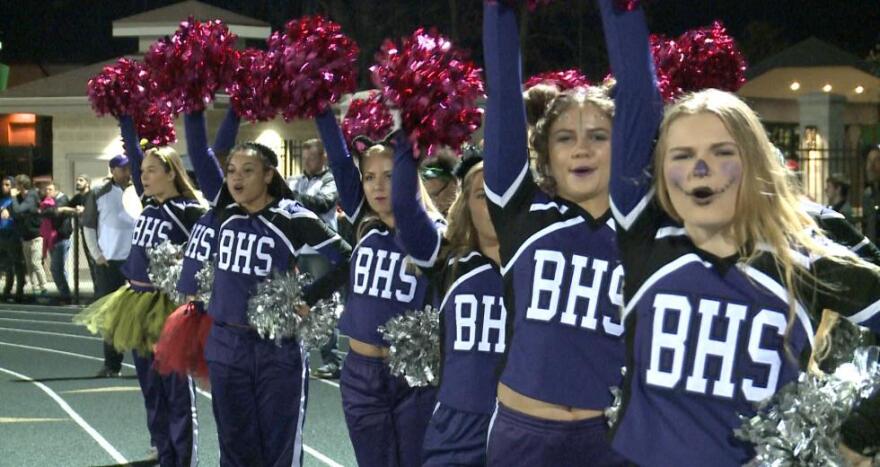This Election Day, voters in nearly four-dozen Ohio school districts will decide if they want to increase local taxes to pay for their schools. But even more – about 70 districts -- are asking voters to renew existing taxes. And just about all of them are dealing with a nuance of state law that ensures the districts will have to go back to the voters again in a few years. That’s because property tax concerns of more than 40 years ago are still shaping the way we pay for schools today.
Barberton City Schools
Hundreds of Barberton City Schools football fans pack the stands on a rainy Friday night to cheer on the Magics, their purple and white clad football team. The team went undefeated in the regular season and hosts its first home playoff game November 3.
Barberton Schools Superintendent Jeff Ramnytz hopes the team’s success this season will motivate his community to renew a $15 million levy, which helps to pay for athletics in his district.
“Back in 2013, we were in some tough times,” Ramnytz said, reflecting on the levy’s first appearance on the ballot.
“We had cut busing, we were talking about going down to half day kindergarten, we had students that were paying to participate in extracurricular activities,” he said. “It was not good.”
The Barberton levy renewal will pay for more than just athletics. Classified as an emergency levy, Ramnytz said his district is not necessarily facing an emergency, but the levy does help to cover basic operating costs in the district and without it, he will have to make cuts.
House Bill 920 and School Levies
Some 220 other districts in Ohio placed either operating or capital levies on the ballot this year, largely paid for through property taxes.
“In Ohio, that’s a low number. That’s half of the historical average going back to 1984,” Howard Fleeter said. He’s a Columbus-based economist who’s been tracking and analyzing school funding in the state for decades.
Fleeter said historically, Ohio relies more heavily on school levies than any other state in the country because of one piece of legislation, House Bill 920.
“What Ohio has done with House Bill 920 is provide a lot of protection to taxpayers at the expense of local governments,” Fleeter said.
In the 1970s, the country experienced a quick rise in inflation, which made property values skyrocket. Fleeter said homeowners worried they wouldn’t be able to afford the taxes on their homes so states took action.
In Ohio, that action came in the form of House Bill 920.
Fleeter explained House Bill 920 is like a guaranteed tax price for homeowners. Over time, the value of a home fluctuates, and the rise or fall of the value affects the property tax a homeowner pays.
When voters approve a levy, HB 920 says voters have agreed to pay a set amount of additional money to fund local programs and that amount can’t change. If a property value goes up, the levy rate, or the percent of tax charged on that property, must come down, and vice versa. The goal is to ensure the average homeowner pays about the same amount over the course of the levy.
The Problem with Cost
Damon Asbury with the Ohio School Board Association said that system causes a problem for schools.
“You have increased teacher salaries, you have the increased cost of supplies, you have increased cost of electricity and bus purchases and gasoline,” he said.
Costs rise, whether because of inflation or just the price of doing business, Asbury said, but House Bill 920 limits a school district’s local income. So year-after-year, it must return to its community to ask for more funding to make up the difference.
Why Are Fewer Levies on the Ballot?
In more than three decades, Ohio voters have on average cast ballots on 434 operating and capital levies each year, but about 10 years ago, that number started to decrease.
In 2017, there were 224 levies on Ohio ballots over three elections.
“I think going back over the last decade, it’s become more and more difficult for districts to get new money issues approved and, therefore, a lot of districts have steered away from trying to put new money requests on the ballot,” Asbury said.
He explained the drop is largely because of the economic downturn the state faced in the early 2010s. It forced districts to turn to cost cutting rather than revenue increasing measures.
But districts can only cut so much, Asbury said, and he thinks many are reaching their breaking point. He’s betting next year the number of levies will start to rebound.
Of the 125 levies on the ballot Tuesday, Fleeter said history tells us 53 percent will pass, but for levy renewals, like the one in Barberton City Schools, the passage rate goes up to 94 percent.
And at the polls, it can only help in Barberton that they have an undefeated football team.


